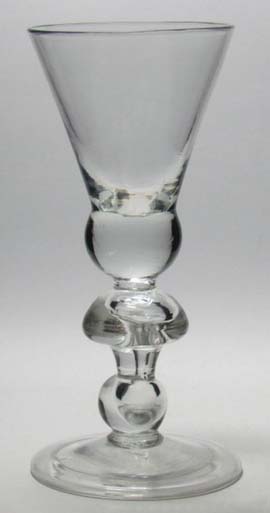Heavy baluster glass
Heavy baluster glass refers to a type of glassware that was popular in England during the late 17th and early 18th centuries. Characterized by their thick stems, which often include a bulbous knop, these glasses were primarily used for drinking wine and other spirits. The term "baluster" is derived from the resemblance of the stem shapes to the balusters used in staircase railings. Heavy baluster glasses are notable for their robust construction and elaborate designs, making them highly prized by collectors of antique glassware today.
History[edit | edit source]
The production of heavy baluster glasses peaked between 1685 and 1715, a period that coincides with the reign of William III and Queen Anne. These glasses were hand-blown, and their weight and thickness provided a durable quality that was much needed before the advent of modern glass-making technologies. The heavy baluster style evolved from the earlier Venetian glass techniques, adapting to the preferences and needs of the English market.
Design and Features[edit | edit source]
The most distinctive feature of heavy baluster glasses is their thick, heavy stem, which often includes one or more knops—bulbous decorations that could be spherical, angular, or tear-shaped. The foot of the glass is usually broad and domed, providing stability. The bowls of these glasses vary in shape, including round, conical, and cylindrical forms, often designed to enhance the experience of drinking specific types of wine or spirits.
Collectibility[edit | edit source]
Today, heavy baluster glasses are highly sought after by collectors and enthusiasts of antique glassware. Their value is determined by factors such as age, condition, rarity, and the intricacy of the design. Authentic pieces can fetch high prices at auction, and they are often featured in museum collections dedicated to the history of glassmaking.
Preservation and Care[edit | edit source]
Preserving heavy baluster glasses requires careful handling and storage. It is recommended to keep them in a stable environment, away from extreme temperatures and direct sunlight, which can damage the glass over time. Cleaning should be done gently by hand, using mild detergents and soft cloths to avoid scratching the surface.
Conclusion[edit | edit source]
Heavy baluster glasses are a testament to the skill and creativity of early modern English glassmakers. Their enduring appeal lies not only in their aesthetic beauty but also in their historical significance, offering a tangible connection to the social and cultural life of the period. As objects of both artistic and historical interest, they continue to captivate collectors and historians alike.
Search WikiMD
Ad.Tired of being Overweight? Try W8MD's physician weight loss program.
Semaglutide (Ozempic / Wegovy and Tirzepatide (Mounjaro / Zepbound) available.
Advertise on WikiMD
|
WikiMD's Wellness Encyclopedia |
| Let Food Be Thy Medicine Medicine Thy Food - Hippocrates |
Translate this page: - East Asian
中文,
日本,
한국어,
South Asian
हिन्दी,
தமிழ்,
తెలుగు,
Urdu,
ಕನ್ನಡ,
Southeast Asian
Indonesian,
Vietnamese,
Thai,
မြန်မာဘာသာ,
বাংলা
European
español,
Deutsch,
français,
Greek,
português do Brasil,
polski,
română,
русский,
Nederlands,
norsk,
svenska,
suomi,
Italian
Middle Eastern & African
عربى,
Turkish,
Persian,
Hebrew,
Afrikaans,
isiZulu,
Kiswahili,
Other
Bulgarian,
Hungarian,
Czech,
Swedish,
മലയാളം,
मराठी,
ਪੰਜਾਬੀ,
ગુજરાતી,
Portuguese,
Ukrainian
Medical Disclaimer: WikiMD is not a substitute for professional medical advice. The information on WikiMD is provided as an information resource only, may be incorrect, outdated or misleading, and is not to be used or relied on for any diagnostic or treatment purposes. Please consult your health care provider before making any healthcare decisions or for guidance about a specific medical condition. WikiMD expressly disclaims responsibility, and shall have no liability, for any damages, loss, injury, or liability whatsoever suffered as a result of your reliance on the information contained in this site. By visiting this site you agree to the foregoing terms and conditions, which may from time to time be changed or supplemented by WikiMD. If you do not agree to the foregoing terms and conditions, you should not enter or use this site. See full disclaimer.
Credits:Most images are courtesy of Wikimedia commons, and templates Wikipedia, licensed under CC BY SA or similar.
Contributors: Prab R. Tumpati, MD

